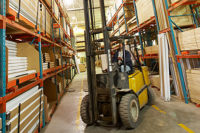One manufacturer says that while it used to get calls requesting safety knives after an employee would get a bad cut, companies are now being proactive and switching to safety knives to prevent injuries, sometimes serious lost-time injuries due to cuts, and accompanying workers’ comp claims.
Menasha Packaging in Neenah, Wisc., switched from standard utility knives to safety knives a decade ago and has seen a dramatic decrease in lacerations, according to Environmental Safety Manager Rick Krause.
The cost of a cut is just too high to be ignored. OSHA estimated that the total cost of a laceration to which an employer pays is $36,472 — a combination of the direct costs of $17,368 and indirect costs of $19,104. This estimate may seem excessive; however, it takes into consideration a company’s profit margin, the average cost of an injury, and an indirect cost multiplier to project the amount of sales a company would need to generate to cover those costs. (http://www.osha.gov/dcsp/smallbusiness/safetypays/estimator.html)
Select the safest knife
While safety knives are standard in most production and distribution plants, any facility that opens a box or cuts string, strapping, rope, plastics and bags should consider adopting a safe-knife policy.
The safest knife is one that does not allow employees to have contact with a blade. Many safety cutters are designed so the blade is covered either by hoods or guards, or they have an auto-retract feature, where the blade recedes immediately after cutting material. If an application demands an exposed blade, choose one that has a safety precaution to retract immediately. The longer a blade is exposed, the more risk to the employee.
Test various knives. Before deciding to change your company’s knife program, find the safest knife for the application and then trial run with employees. Keep in mind, change is the biggest obstacle in safety, and employees are resistant to give up open-bladed knives or may choose a knife that’s easy to override the safety feature. Employer involvement in training and testing is essential.
If a disposable knife is chosen, replace the knife when the blades dull. Employees will tug and damage a dull bladed knife, making it no longer safe. When replacing blades, find a safe location and create a system where dull blades can be replaced and disposed. Blade change creates the greatest risk for getting cut and takes time away from productivity.
A broad range of safety cutter’s in today’s market has made safe-knife programs available for every industry. The evolution of the open-bladed knife to today’s user-friendly safety knives has made many companies proactive in reducing laceration injuries. How about yours?

